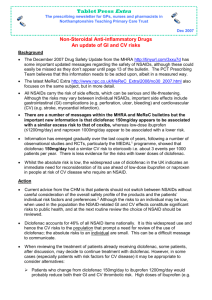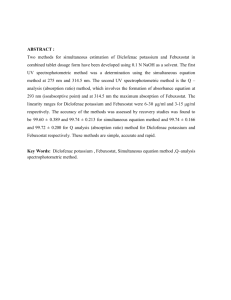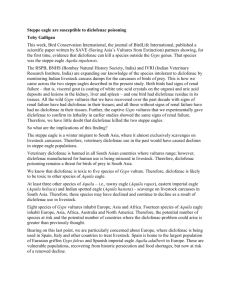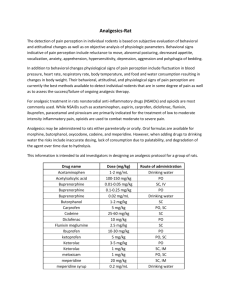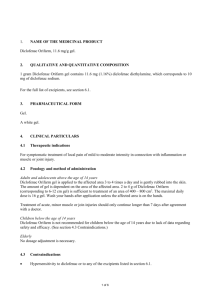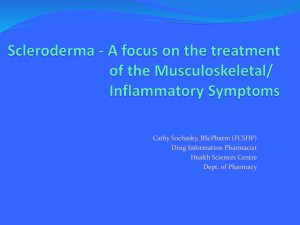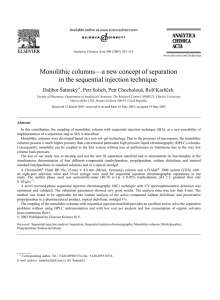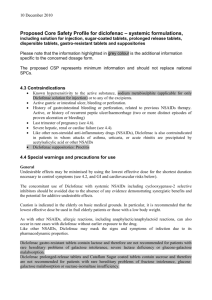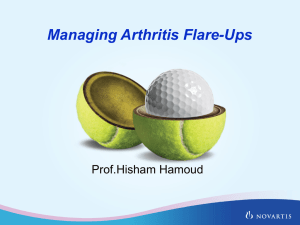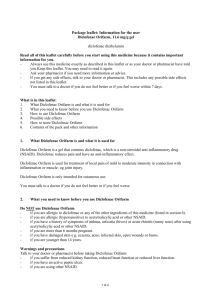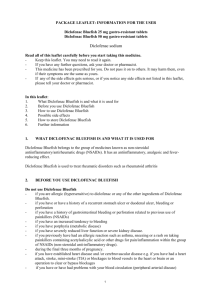P K Dash - Journal of Evidence Based Medicine and Healthcare
advertisement
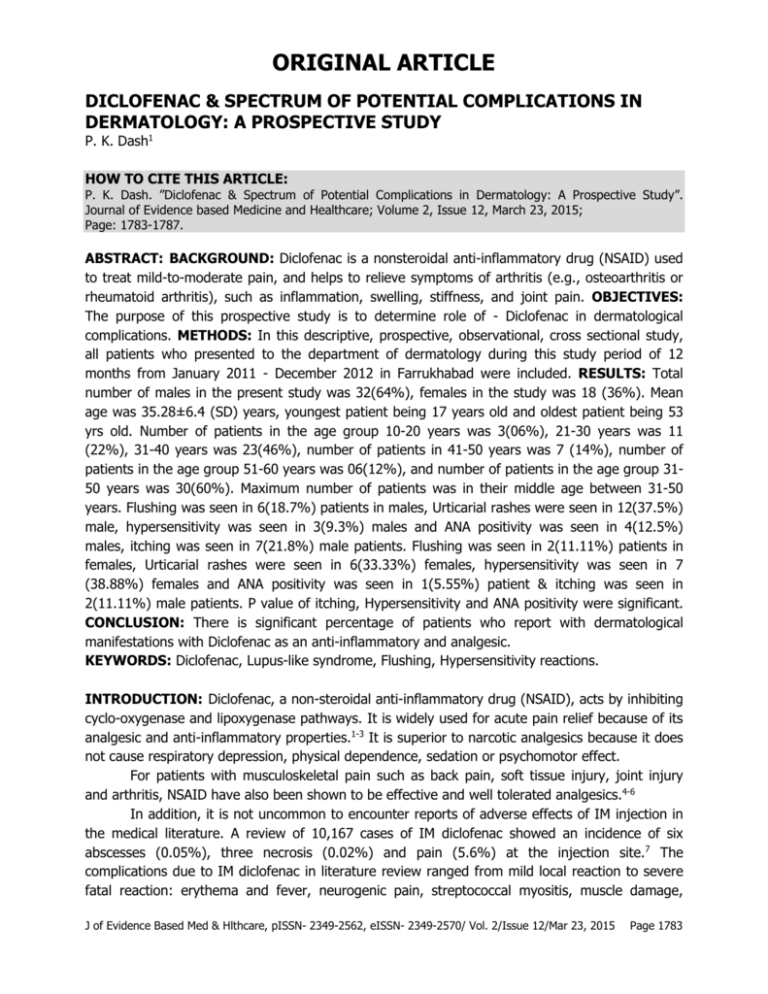
ORIGINAL ARTICLE DICLOFENAC & SPECTRUM OF POTENTIAL COMPLICATIONS IN DERMATOLOGY: A PROSPECTIVE STUDY P. K. Dash1 HOW TO CITE THIS ARTICLE: P. K. Dash. ”Diclofenac & Spectrum of Potential Complications in Dermatology: A Prospective Study”. Journal of Evidence based Medicine and Healthcare; Volume 2, Issue 12, March 23, 2015; Page: 1783-1787. ABSTRACT: BACKGROUND: Diclofenac is a nonsteroidal anti-inflammatory drug (NSAID) used to treat mild-to-moderate pain, and helps to relieve symptoms of arthritis (e.g., osteoarthritis or rheumatoid arthritis), such as inflammation, swelling, stiffness, and joint pain. OBJECTIVES: The purpose of this prospective study is to determine role of - Diclofenac in dermatological complications. METHODS: In this descriptive, prospective, observational, cross sectional study, all patients who presented to the department of dermatology during this study period of 12 months from January 2011 - December 2012 in Farrukhabad were included. RESULTS: Total number of males in the present study was 32(64%), females in the study was 18 (36%). Mean age was 35.28±6.4 (SD) years, youngest patient being 17 years old and oldest patient being 53 yrs old. Number of patients in the age group 10-20 years was 3(06%), 21-30 years was 11 (22%), 31-40 years was 23(46%), number of patients in 41-50 years was 7 (14%), number of patients in the age group 51-60 years was 06(12%), and number of patients in the age group 3150 years was 30(60%). Maximum number of patients was in their middle age between 31-50 years. Flushing was seen in 6(18.7%) patients in males, Urticarial rashes were seen in 12(37.5%) male, hypersensitivity was seen in 3(9.3%) males and ANA positivity was seen in 4(12.5%) males, itching was seen in 7(21.8%) male patients. Flushing was seen in 2(11.11%) patients in females, Urticarial rashes were seen in 6(33.33%) females, hypersensitivity was seen in 7 (38.88%) females and ANA positivity was seen in 1(5.55%) patient & itching was seen in 2(11.11%) male patients. P value of itching, Hypersensitivity and ANA positivity were significant. CONCLUSION: There is significant percentage of patients who report with dermatological manifestations with Diclofenac as an anti-inflammatory and analgesic. KEYWORDS: Diclofenac, Lupus-like syndrome, Flushing, Hypersensitivity reactions. INTRODUCTION: Diclofenac, a non-steroidal anti-inflammatory drug (NSAID), acts by inhibiting cyclo-oxygenase and lipoxygenase pathways. It is widely used for acute pain relief because of its analgesic and anti-inflammatory properties.1-3 It is superior to narcotic analgesics because it does not cause respiratory depression, physical dependence, sedation or psychomotor effect. For patients with musculoskeletal pain such as back pain, soft tissue injury, joint injury and arthritis, NSAID have also been shown to be effective and well tolerated analgesics.4-6 In addition, it is not uncommon to encounter reports of adverse effects of IM injection in the medical literature. A review of 10,167 cases of IM diclofenac showed an incidence of six abscesses (0.05%), three necrosis (0.02%) and pain (5.6%) at the injection site.7 The complications due to IM diclofenac in literature review ranged from mild local reaction to severe fatal reaction: erythema and fever, neurogenic pain, streptococcal myositis, muscle damage, J of Evidence Based Med & Hlthcare, pISSN- 2349-2562, eISSN- 2349-2570/ Vol. 2/Issue 12/Mar 23, 2015 Page 1783 ORIGINAL ARTICLE tissue necrosis and the Nicolau syndrome, ischaemic stroke, hypoxic brain damage, anaphylactic shock, and even death.8 The complications due to PO diclofenac in literature review ranged from Rashes, hypersensitivity reactions to petechiae and systemic complications including A cute kidney injury. This prospective, observational study is designed to study the dermatological manifestations occurring due to Diclofenac.9-11 MATERIALS & METHODS: STUDY DESIGN: Prospective, observational, cross sectional study. SAMPLE SIZE: 50 cases over a span of 12 months from January 2011-December 2012 in Farrukhabad were included. Method of Collection of Data: The data for the purpose of the study was collected in a predesigned and pretested proforma which include various socioeconomic parameters like age, sex, occupation, religion, etc. About 50 cases were selected on the basis of the simple random sampling method. Patients who were given Diclofenac, Patients who presented with dermatological manifestations during the period of treatment with diclofenac. The statistically data was analyzed with the help of software SPSS.16.0, Chi-square test was done. Questionnaires, physical, radiographic examination was done in all patients. INCLUSION CRITERIA: Patients with dermatological manifestations, and who were initiated with Diclofenac as a therapy 50 mg PO BD to TDS dose being used for more than a week in the last 6 months. EXCLUSION CRITERIA: Patients who were on long term Diclofenac with no dermatological symptoms. Patients with overt allergy to NSAIDs. RESULTS: Table. 1 Shows total number of males in the present study was 38 (64%), females in the study was 18 (36%). Mean age of the patients was 35.28±6.4 (SD) years, youngest patient being 17years old and oldest patient being 53yrs old. Table. 2 Shows age distribution according to groups in present study, number of patients in the age group 10-20 years was 3(06%), 21-30 years was 11(22%), 31-40 years was 23(46%), number of patients in 41-50 years was 7(14%), number of patients in the age group 51-60 years was 06(12%), number of patients in the age group 31-50 years was 30(60%). Maximum number of patients was in their middle age between 31-50 years. Table. 3 Showing distribution of symptoms in present study, flushing was seen in 8(16%) patients, Urticarial rashes were seen in 18(36%) patients, Hypersensitivity reactions was seen in 10(20%) patients, ANA-positive was seen in 5(10%) patients, Itching was seen in 9(18%) patients, Hypersensitivity reactions were seen in maximum number of patients i.e. in 18(36%) patients. J of Evidence Based Med & Hlthcare, pISSN- 2349-2562, eISSN- 2349-2570/ Vol. 2/Issue 12/Mar 23, 2015 Page 1784 ORIGINAL ARTICLE Table. 4 show symptoms in different sex distribution. Flushing was seen in 6(18.7%) patients in males, Urticarial rashes were seen in 12(37.5 %) male, hypersensitivity was seen in 3(9.3%) males and ANA positivity was seen in 4(12.5%) males, itching was seen in 7(21.8%) male patients. Flushing was seen in 2(11.11%) patients in females, Urticarial rashes were seen in 6(33.33%) females, hypersensitivity was seen in 7(38.88%) females and ANA positivity was seen in 1(5.55%) patient & itching was seen in 2(11.11%) male patients. P value of itching, Hypersensitivity and ANA positivity were significant. DISCUSSION: This prospective, observational study titled “Diclofenac & Spectrum of potential complications in dermatology-A Prospective study.” In our locality, renal colic, acute musculoskeletal injury and arthritis are common painful conditions requiring NSAID. With conflicting evidences for the superior effect of IM NSAID or PO NSAID. Excessive use is not being justified. Superiva et al4 compared piroxicam fast-dissolving dosage form (FDDF) versus IM diclofenac sodium in the treatment of acute renal colic. He concluded that piroxicam FDDF was as effective as parenteral diclofenac. Therefore, with the development of fast absorption oral NSAID, it may be possible to change giving IM NSAID. The tolerability profile of diclofenac is well established, as wide experience has been gained with the drug in clinical practice. About 12% of patients experience side effects, which are usually mild and transient, and 1.5% to 2% have the drug withdrawn. Side effects usually occur in the first 6 months of treatment, and they are not more frequent in the elderly. As with other NSAIDs, gastrointestinal problems are the most frequent effects, followed by minor CNS, dermatological symptoms and allergic or local reactions.6 Diclofenac is well tolerated compared with other NSAIDs, and no other agent of this class appears to have a side effect profile which is clearly superior to diclofenac. Aspirin produces more frequent and more severe gastrointestinal effects than diclofenac, and tinnitus and hearing loss are only extremely rarely associated with diclofenac. Indomethacin clearly produces more CNS effects than diclofenac, and gastrointestinal complaints are also somewhat more frequent with indomethacin. The tolerability of diclofenac appears similar to other commonly used NSAIDs such as ibuprofen, ketoprofen and naproxen.9-11 As with any drug which has been used so extensively, a number of extremely rare or serious adverse effects have been associated with diclofenac. Dermatological manifestations occur rarely, Gastrointestinal ulceration appears rarely associated with diclofenac compared with many other NSAIDs: there were only 8 reports in 85,361 patients (0.009%) treated with the drug. Although rare and isolated cases of hepatitis, severe renal damage and severe haematological complications have been reported, other NSAIDs have also been associated with these problems. In addition, diclofenac is rarely or never associated with some other serious side effects caused by other commonly used NSAIDs, e.g. acute pancreatitis, aseptic meningitis, or severe cutaneous or phototoxic reactions. Our study shows there is predominance of dermatological symptoms among the male subjects and the female being affected in lesser proportion, even though major symptom profile studied here is very limited and purely concentrated on the dermatological manifestation. The J of Evidence Based Med & Hlthcare, pISSN- 2349-2562, eISSN- 2349-2570/ Vol. 2/Issue 12/Mar 23, 2015 Page 1785 ORIGINAL ARTICLE number of patients included in our study is limited, but still this study shows a new symptom profile. Since the manifestations seen may be a secondary manifestation to systemic diseases which acted in cohesion for the symptom. Most of the patients in our study were having hypertension and were on medication for the same. However, there were no patients with CKD in our study. Further, randomised control studies will help in this regard to understand the drug complication profile in all the individuals. REFERENCES: 1. Skoutakis VA, Carter CA, Mickle TR, et al. Review of diclofenac and evaluation of its place in therapy as a nonsteroidal antiinflammatory agent. Drug Intell Clin Pharm 1988; 22(11): 850-9. 2. Babic-Naglic D. Voltaren – the gold standard. Reumatizam 2000; 47(2): 29-31. 3. Kantor TG. Use of diclofenac in analgesia. Am J Med 1986; 80(4B): 64-9. 4. Van Tulder MW, Scholten RJ, Koes BW, Deyo RA. Non-steroidal anti-inflammatory drugs for low back pain. Cochrane Database Syst Rev 2000; (2): CD000396. 5. Ng P, Kam CW, Yau HH. A comparison of ketoprofen and diclofenac for acute musculoskeletal pain relief: a prospective randomized clinical trial. Hong Kong J Emerg Med 2001; 8(2): 73-7. 6. Moran M. Double-blind comparison of diclofenac potassium, ibuprofen and placebo in the treatment of ankle sprains. J Int Med Res 1991; 19(2): 121-30. 7. Serratrice G. Study of diclofenac injectable. Tribune Medicine 1982; 46: 43-8. 8. Todd PA, Sorkin EM. Diclofenac sodium. A reappraisal of its pharmacodynamic and pharmacokinetic properties, and therapeutic efficacy. Drugs 1988; 35(3): 244-85. 9. Schaad HJ, Zurcher RM. Erythema and fever after diclofenac i.m. Ther Umsch 1998; 55(9): 586-8. 10. Horowitz SH. Iatrogenic causalgia. Classification, clinical findings, and legal ramifications. Arch Neurol 1984; 41(8): 821-4. 11. De Courcy JG, Nicholls BJ. Neurogenic pain associated with diclofenac injection. Anaesthesia 1993; 48(5): 455. 12. Power I. Muscle damage with diclofenac injections. Anaesthesia 1992; 47(5): 451. Group Number of patients Percentage (%) Males 32 64 Females 18 36 Total 25 100 Table 1: showing prevalence of present study Age 10-20 21-30 31-40 41-50 Frequency 03 11 23 07 Percentage (%) 06 22 46 14 J of Evidence Based Med & Hlthcare, pISSN- 2349-2562, eISSN- 2349-2570/ Vol. 2/Issue 12/Mar 23, 2015 Page 1786 ORIGINAL ARTICLE 51-60 Total 06 50 12 100 Table 2: Showing age distribution according to groups in present study Symptoms Flushing Urticarial rash Hypersensitivity reactions ANA-positive Itching Total Present 8 18 10 5 9 50 (%) 16 36 20 10 18 100 Table 3: Showing symptoms according to groups in present study Symptoms Males (n=32) (%) Females (n=18) (%) P value Flushing 6 18.7 2 11.11 0.65 Urticarial rash 12 37.5 6 33.33 0.54 Hypersensitivity reactions 3 9.3 7 38.88 0.001 ANA-positive 4 12.5 1 5.55 0.001 Itching 7 21.8 2 11.11 0.001 Table 4: Showing distribution of symptoms in different age groups LIST OF ABBREVIATIONS: CKD - Chronic Kidney Disease. e.g. - Example. i.e. - that is NSAID - Nonsteroidal anti-inflammatory drug. SD - standard deviation. WHO - World Health Organization AUTHORS: 1. P. K. Dash PARTICULARS OF CONTRIBUTORS: 1. Assistant Professor, Department of Dermatology, Hi-tech Medical College, Bhubaneswar, Odisha. NAME ADDRESS EMAIL ID OF THE CORRESPONDING AUTHOR: Dr. P. K. Dash, Department of Dermatology, Hi-tech Medical College, Bhubaneswar, Odisha. E-mail: dr_pkdash@rediffmail.com Date Date Date Date of of of of Submission: 13/03/2015. Peer Review: 14/03/2015. Acceptance: 17/03/2015. Publishing: 18/03/2015. J of Evidence Based Med & Hlthcare, pISSN- 2349-2562, eISSN- 2349-2570/ Vol. 2/Issue 12/Mar 23, 2015 Page 1787
